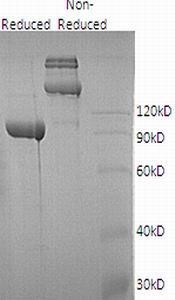Recombinant Human C-C Motif Chemokine 16/CCL16
Shipping Info:
For estimated delivery dates, please contact us at [email protected]
| Amount : | 50 µg |
| Content : | Lyophilized from a 0.2 µm filtered solution of 20mM PB, 150mM NaCl, pH 7.4. |
| AA sequence : | Recombinant Human C-C Motif Chemokine 16 is produced by our E.coli expression system and the target gene encoding Gln24-Gln120 is expressed. |
| Alternative Name : | C-C Motif Chemokine 16, Chemokine CC-4, HCC-4, Chemokine LEC, IL-10-Inducible Chemokine, LCC-1, Liver-Expressed Chemokine, Lymphocyte and Monocyte Chemoattractant, LMC, Monotactin-1, MTN-1, NCC-4, Small-Inducible Cytokine A16, CCL16, ILINCK, NCC4, SCYA16 |
Source : E. coli;
CCL16 is a member of CC chemokine family. CCL16 cDNA encodes a 120 amino acid peptide along with a 23 amino acids signal peptide that is cleaved to generate 97 amino acid protein. CCL16 is distantly related to other CC chemokines, showing less than 30% sequence identity. CCL16 elicits its effects on cells by interacting with cell surface chemokine receptors such as CCR1, CCR2, CCR5 and CCR8. Recombinant CCL16 has been shown to chemoattract human monocytes and THP1 cells but not resting lymphocytes nor neutrophils. CCL16 has potent myelosuppressive activity, suppresses proliferation of myeloid progenitor cells. CCL16ninduces a calcium flux in THP1 cells that can be desensitized by prior exposure to RANTES, suggesting that CCL16 and RANTES share the same receptor in THP1 cells.
CCL16 is a member of CC chemokine family. CCL16 cDNA encodes a 120 amino acid peptide along with a 23 amino acids signal peptide that is cleaved to generate 97 amino acid protein. CCL16 is distantly related to other CC chemokines, showing less than 30% sequence identity. CCL16 elicits its effects on cells by interacting with cell surface chemokine receptors such as CCR1, CCR2, CCR5 and CCR8. Recombinant CCL16 has been shown to chemoattract human monocytes and THP1 cells but not resting lymphocytes nor neutrophils. CCL16 has potent myelosuppressive activity, suppresses proliferation of myeloid progenitor cells. CCL16ninduces a calcium flux in THP1 cells that can be desensitized by prior exposure to RANTES, suggesting that CCL16 and RANTES share the same receptor in THP1 cells.
|
There are currently no product reviews
|














.png)










